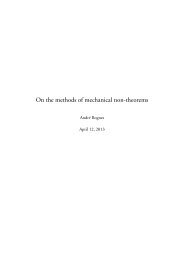The passive voice in written and spoken Scandinavian
The passive voice in written and spoken Scandinavian
The passive voice in written and spoken Scandinavian
Create successful ePaper yourself
Turn your PDF publications into a flip-book with our unique Google optimized e-Paper software.
Let us first look at the overall distribution of modals with <strong>passive</strong><br />
complements, as presented <strong>in</strong> Table 9 for <strong>written</strong> language <strong>and</strong> Table 10 for <strong>spoken</strong><br />
language.<br />
Danish Norwegian Swedish<br />
s-<strong>passive</strong> bli-<strong>passive</strong> s-<strong>passive</strong> bli-<strong>passive</strong> s-<strong>passive</strong> bli-<strong>passive</strong><br />
modal<br />
<strong>passive</strong><br />
43.2% (120) 6.4% (10) 53.7% (145) 11.7% (19) 25.1% (129) –<br />
Total 278 156 270 162 513 7<br />
Table 9. Modals with <strong>passive</strong> complement <strong>in</strong> <strong>written</strong> language<br />
<strong>The</strong> results from our newspaper corpus (Table 9) show two rather clear trends. It is<br />
the morphological <strong>passive</strong> that dom<strong>in</strong>ates <strong>in</strong> comb<strong>in</strong>ation with the modal verb. This<br />
is so for all three languages, although the relative frequency between the languages<br />
varies quite substantially. <strong>The</strong> frequency is highest <strong>in</strong> Norwegian, where the<br />
morphological <strong>passive</strong> complement accounts for 53.7% of all s-<strong>passive</strong>s, <strong>and</strong> lowest<br />
<strong>in</strong> Swedish, where it accounts for one-fourth of all s-<strong>passive</strong>s. Modal verbs with<br />
periphrastic <strong>passive</strong> complements are rare <strong>in</strong> all three languages. Norwegian, aga<strong>in</strong>,<br />
has the highest number of modal <strong>passive</strong>s (11.7%). In the Swedish sample, the<br />
periphrastic <strong>passive</strong> construction turned out to be very <strong>in</strong>frequent (7 occurrences);<br />
none of these occurred together with a modal verb.<br />
Danish Norwegian Swedish<br />
s-<strong>passive</strong> bli-<strong>passive</strong> s-<strong>passive</strong> bli-<strong>passive</strong> s-<strong>passive</strong> bli-<strong>passive</strong><br />
modal<br />
<strong>passive</strong><br />
88.5% (549) 3.4% (70) 61.0% (130) 4.5% (37) 25.3% (193) 9.8% (14)<br />
Total 620 2066 213 830 764 143<br />
Table 10. Modals with <strong>passive</strong> complement <strong>in</strong> <strong>spoken</strong> language<br />
Turn<strong>in</strong>g to the results <strong>in</strong> the <strong>spoken</strong> language corpora (Table 10), some changes can<br />
be noticed, although the overall tendencies rema<strong>in</strong> the same as <strong>in</strong> <strong>written</strong> language.<br />
Here aga<strong>in</strong> the morphological <strong>passive</strong> is dom<strong>in</strong>at<strong>in</strong>g <strong>in</strong> modal constructions, whereas<br />
the frequency of modal verbs with a periphrastic <strong>passive</strong> complement rema<strong>in</strong>s under<br />
10%. Swedish has the highest proportion (9.8%) <strong>and</strong> Danish the lowest (3.4%).<br />
24

















